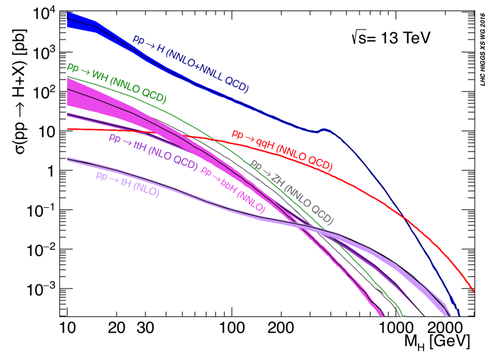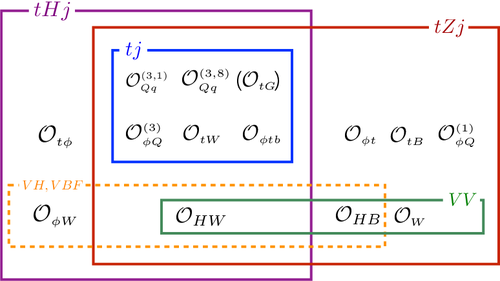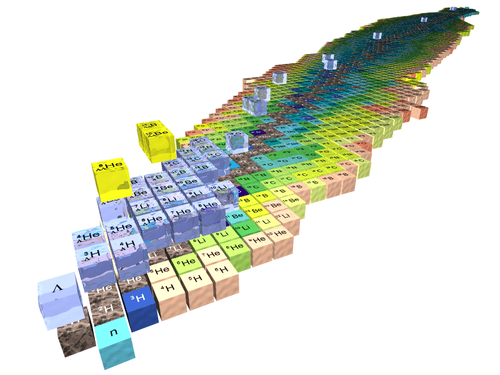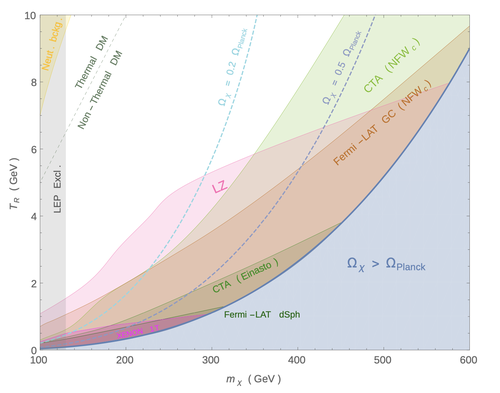Phenomenology of fundamental interactions
Our current understanding of the fundamental interactions at high energies is encapsulated in the Standard Model, which includes strong and electroweak interactions, both in the perturbative and non-perturbative (e.g., hadronic and nuclear physics) regimes. A wide set of experiments based on the acceleration of beams of particles or nuclei to high energy or at high intensity, such as those running at the CERN, Fermilab, Brookhaven laboratories and based on observations on earth or in space, have largely confirmed the predictions of the Standard Model. Nevertheless many questions remain unanswered.
Neutrino masses, dark matter and the baryon asymmetry of the Universe indicate that the standard model is incomplete. Understanding the origin of neutrino masses and mixing, the identity of dark matter and the mechanism of baryon asymmetry generation can guide us in unveiling the physics BSM. Our research addresses these questions theoretically and in connection with current and future particle physics experiments and with the implications that these can have on the origin, history and evolution of the Universe. The recently discovered Higgs boson potentially also holds a unique key to uncover new physics BSM as its properties and in particular the Higgs potential and its couplings to first and second fermion generational have just started to be explored. Another area of intense research is the dynamics of strong and nuclear interactions at high density and temperatures which still holds many mysteries.

Research activities
Precision physics at colliders
Our interest focuses on the development of new approaches to efficiently obtain predictions in the context of the Standard Model for observables that are accessible at present and future colliders. In particular, we work on new computational techniques and perturbative methods to compute multi-loop amplitudes and their inclusion in NNLO computations, on MC generators (such as MadGraph5_aMC@NLO) for the simulations of events at high energy, and on the phenomenology of the Standard Model and the study of new physics scenarios [F.Maltoni, D.Pagani, T.Peraro].

Effective field theories
The existence of the physics beyond the Standard Model can be investigated either with a top-down model-building-inspired approach focused on the search of new resonances, or with a bottom-up method that looks for new interactions among the known particles. In the second case, the effective field theory method provides a consistent and systematic framework to the interpretation of the experimental results.
In this context, we work on providing accurate predictions for collider observables in the SMEFT framework relevant for Higgs, EW, and top quark phenomenology, and then extracting constraints on new physics properties by performing global fits to precision data [F.Maltoni, L.Pagani]. Following a top-down approach, we study the low-energy consequences of specific BSM scenarios [L.Pagani] and we consider EFT at the TeV scales which can be characterised by specific symmetries connected to UV complete theories or by the presence of closed fixed-points in the theory space. [G.P.Vacca, L. Zambelli].
Neutrino theory and phenomenology
The discovery of neutrino oscillations in 1998 implies that neutrinos have mass and mix, contrary to the predictions of the Standard Model. A precise picture of neutrino properties have been provided by a wealth of experiments. Some open questions remain, namely the value of neutrino masses, the violation of the CP symmetry in the leptonic sector, the precise values of the mixing parameters and the test of the standard 3-neutrino paradigm. The questions are crucial to understand the origin of neutrino masses and mixing in extensions of the Standard Model.
We study neutrino properties assessing the physics reach of current and future experiments in their determination, with emphasis on short, e.g. MicroBooNE, and long, e.g. DUNE, baseline neutrino oscillation experiments and neutrino less double beta decay [S. Pascoli, D. Massaro], and we exploit the neutrino portal to hunt for hidden sectors. On the theoretical side, the origin of neutrino masses calls for a new energy scale: our approach is to consider the broadest range going from low scale see-saw models to the GUT scale and to identify the phenomenological signatures of such models, e.g. leptogenesis, GeV-scale heavy neutral leptons [S. Pascoli]. From an astroparticle physics perspective, we exploit the key role neutrinos had in the evolution of the Universe to pin down their properties, in particular the precise measurement of neutrino masses, and their possible connection to dark matter [S. Pascoli].
Scattering in the Regge limit
The Regge regime is of special interest in hadronic processes as it gives the opportunity of exploring properties of QCD in extreme situations, such as those characterized by high partonic densities. Studies of hard and semi-hard processes have allowed to organise the contributions through BKFL-type of resummations. In this context our interest is towards the characterisation of the effective field theories that follow [G.P.Vacca].

Nuclear interactions
Our research activity is focused on the strong interactions, which are responsible of the internal structure of the protons and neutrons. In particular, we study i) elastic reactions between hadrons on finite nuclei starting from a many-body microscopic approach; ii) elastic and quasi-elastic electrons as a method to measure the distribution of protons and neutrons in nuclear systems; iii) mean-field approaches to the description of the nuclear structure; iv) nuclear superconductivity [P.Finelli].

Implications of string theory for particle physics
The low-energy limit of string theory gives rise to ordinary gauge theories in a supergravity framework with the presence of extra dimensions and branes. Our goal is to reproduce Standard Model physics and to provide new ways to solve its problems. In particolar we study supersymmetry breaking mechanisms and spectra of supersymmetric particles, moduli phenomenology, non-thermal scenarios for dark matter and baryogenesis, hidden sector physics, axions and new gauge bosons [M.Cicoli, V.Guidetti, I.Broeckel].
Baryon asymmetry
The universe is observed to contain way more matter than antimatter. This matter-antimatter, or baryon, asymmetry is not explained by our current understanding of the fundamental laws of nature. We work on building new models that explain the observed baryon asymmetry of the universe, with the aims to open new ways to observationally test the origin of matter (e.g. with gravitational waves and with high-intensity and high-energy colliders) and/or to open new connections with other BSM avenues like neutrino masses, dark matter and supersymmetry. We also work on signatures of models of baryogenesis and leptogenesis at neutrino detectors and at various accelerator facilities. [M. Lucente, S. Pascoli, F. Sala]
Dark matter searches and models
We know dark matter (DM) exists and makes up 85% of the matter in the universe, but we do not know what it is made of. Its identification is a primary goal of modern science. We work on novel signals of various DM models, for example on the detection at DM and neutrino experiments of the high-energy DM fluxes that necessarily exist, induced e.g. by cosmic-ray upscatterings or by atmospheric showers. Our work on DM signals includes, in addition, those in cosmic rays and in photons and neutrinos from the sky, in cosmological observables, and at high-intensity and high-energy accelerator facilities. We also work on DM models and production mechanisms that offer new ways to test DM, for example with gravitational waves when the DM origin is related to a phase transition in the early universe, and/or that offer new connections with other open problems of our understanding of nature, like neutrino masses, the baryon asymmetry, the hierarchy and flavor problems. [M. Lucente, F. Maltoni, S. Pascoli, F. Sala]
National and international projects and collaborations
Our research activities are also supported by the INFN initiatives, QFT@COLLIDERS [G.P.Vacca, F. Maltoni], MONSTRE (ex MANYBODY) [P.Finelli], ST&FI [M.Cicoli], TAsP [S. Pascoli]. Several collaborations with national (Milano, Torino, Roma, Genova, Pavia, Padova) and international institutions [Brookhaven (US), TRIUMF (CA), UCLouvain (B), CERN (CH), NIKHEF (NL), IHEP (China), Paris (F), Heidelberg (D), DESY (D), MPP München (D), Durham (UK), Cambridge (UK), Oxford (UK), Lund (S), Southampton (UK), Columbia (US), Minnesota (US)] are active.